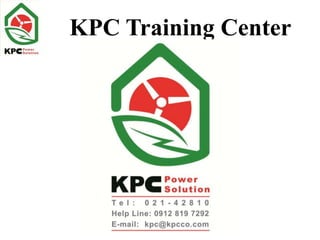Siavash
- 2. Purpose : Stability and reliability of the genset
- 3. Standby Generators must be ready to operate at any time Establishing a PM maintenance program : ïž Minimize Downtime ïž Reduce Engine Operating Costs ïž Increase Engine Life
- 4. Service Repair Time : ïą Run-to-Failure Management ïą Preventive maintenance Management
- 5. Run-to-Failure Management ïž High spare parts inventory cost ïž High overtime labor cost ïž High machine down time ïž Low production availability
- 6. Run-to-Failure Management The net result High maintenance cost Low availability
- 7. Preventive Maintenance (PM) ïž Recommended spare parts ïž Genuine parts ïž Oil, fuel, coolant specification ïž Maintenance schedule: - Daily - Weekly - 250 Hours or 6 month - 1500 Hours or 1 year - 6000 Hours or 2 years - Others
- 9. Importance Lubrication System 70-80% crank failures are due to oil contamination.
- 10. Check Oil Level (Add oil as needed )
- 11. Oil Level & crankshaft :
- 12. Consider these factors when you select engine oil: ïž Oil types (API service classifications) ïą Engine design and construction. ïą Fuel characteristics. ïž Oil viscosity (SAE service classifications) ïą Operating conditions.
- 13. Causes of Lube System Wear & Failure ïž Single largest problem is short engine life due to excessive soot in the oil ïž Poor quality/low performance engine oil ïž Extended oil change intervals ïž Fuel dilution ïž Wear (Lube System Caused) ïž Seals/Bearings ïžTurbo ïžCrank - Main/Rod ïžValve, Guide
- 14. Over-filling the engine oil leads to :
- 18. Check Coolant Level (Add coolant as needed )
- 20. Importance of Cooling System 40-60% Of All Engine Downtime Is Associated With Cooling System Problems Important Customer Reminders: Use proper start up procedures Clean debris from the radiator and fan Check radiator cap seal Inspect the water pump for leaks Select the right coolant
- 21. Causes of Cooling System Wear & Failure âĒ Single most common problem â poor coolant quality Due toâĶ â Not maintaining adequate levels of coolant additives â Using coolant that does not meet Catâs specifications â Not keeping the cooling system topped off â Using coolant past its useful life âĶ most cooling system problems can be avoided with proper maintenance practices!
- 23. Effects of Poor Fuel Quality excessive wear and premature failure of injectors and fuel pump Poor lubricity create combustion chamber deposits => These reduce the life of cylinder liners and rings Fuels that are a heavier grade engine knock, trouble starting, and black exhaust smoke. Low cetane numbers
- 24. Symptoms... ï Clogged and slimy filters ï Dark, hazy fuel ï Sludge build up in tanks ï Loss of power and RPM ï Excess smoke ï Corroded, pitted injectors ï Foul odor
- 25. Battery capacity (minimum recommended cold cranking amps): K50 Generator-Drive Above 10°C [50°F]- Ambient Temperature 1280- Cold Cranking Amperes Above 0 to 32°C [-18 to 0°F]- Ambient Temperature 1800- Cold Cranking Amperes
- 26. Batteries (Specific Gravity) Battery State of Charge Specific Gravity (at 27°C [80°F]) 100% 1.260 to 1.280 75% 1.230 to 1.250 50% 1.200 to 1.220 25% 1.170 to 1.190 DISCHARGED 1.110 to 1.130
- 33. Genset Services Key points âĒ âŦØēŲ اŲ⎠âŦØŊØąâŽ âŦŲ ŲØŠŲØąâŽ âŦØđŲ ŲÚĐØąØŊ⎠âŦاØē⎠âŦاطŲ ÛŲاŲ⎠âŦŲ⎠âŦŲūاÛØŊØ§ØąÛâŽâŦاØķØ·ØąØ§ØąâŽ Standby Power âĒ Fast Start (NFPA 110 3 times start) âĒ Rated Speed (Voltage , Freq.) âĒ Take a load âĒ Battery âĒ Fuel âĒ Oil âĒ Water heater
- 34. Genset Services Key points âĒ âŦØąØ§ŲØŊŲ اŲ⎠âŦاŲØēاÛØī⎠Installation ( Cooling, Room Design, Fan, Exhaust)
- 35. Engine Difficult to Start or Will Not Start (No Exhaust Smoke) ï Fuel level is low in the tank ï Battery charge low ï Fuel shutoff valve(s) closed ï Fuel filter or fuel suction line is restricted ï Air intake system restriction is above specification ï Exhaust system restriction is not within specification ï Fuel is waxing due to cold weather
- 36. Engine Difficult to Start or Will Not Start (Exhaust Smoke) ï Fuel quality is poor ï Air intake system restriction ï Exhaust system restriction ï Engine cranking speed is too slow ï Overhead adjustments are not correct
- 37. Engine Will Not Crank or Cranks Slowly (Electric Starter) ï Battery cables or connections are loose or corroded (excessive resistance) ï Lubricating oil does not meet specifications ï Battery capacity is below specification or Battery voltage is low ï Battery temperature is below specification ï Crankshaft rotation is impaired
- 38. Combustion chamber temperatures drop so low the fuel will not burn completely. carbon to clog the injector spray holes and piston rings and can cause valves to stick.
- 39. ï If the engine coolant temperature becomes too low, 60°C [140°F] , ï raw fuel from incomplete combustion , ï will wash the lubricating oil off the cylinder walls and dilute the crankcase oil; ï all moving parts of the engine will not receive the correct amount of lubrication.
- 40. Thanks for your Attention

























![Battery capacity (minimum recommended cold cranking
amps):
K50 Generator-Drive
Above 10°C [50°F]- Ambient Temperature
1280- Cold Cranking Amperes
Above 0 to 32°C [-18 to 0°F]- Ambient Temperature
1800- Cold Cranking Amperes](https://image.slidesharecdn.com/siavash-151014114503-lva1-app6891/85/Siavash-25-320.jpg)
![Batteries (Specific Gravity)
Battery State of Charge Specific Gravity (at 27°C [80°F])
100% 1.260 to 1.280
75% 1.230 to 1.250
50% 1.200 to 1.220
25% 1.170 to 1.190
DISCHARGED 1.110 to 1.130](https://image.slidesharecdn.com/siavash-151014114503-lva1-app6891/85/Siavash-26-320.jpg)












![ï If the engine coolant temperature becomes too low, 60°C [140°F] ,
ï raw fuel from incomplete combustion ,
ï will wash the lubricating oil off the cylinder walls and dilute the crankcase oil;
ï all moving parts of the engine will not receive the correct amount of lubrication.](https://image.slidesharecdn.com/siavash-151014114503-lva1-app6891/85/Siavash-39-320.jpg)
